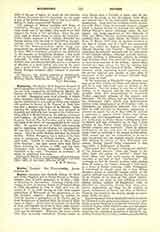

Bourne, GILBERT, last Catholic Bishop of Bath and Wells, England, son of Philip Bourne of Worcestershire, date of birth unknown; d. September 10, 1569, at Silverton in Devonshire. Entering Oxford University in 1524, he became Fellow of All Souls College in 1531, proceeded in Arts in 1532, and was admitted B. D. in 1543, having in 1541 been named prebendary of Worcester on the suppression of the old monastic chapter. Removing to London in 1545 he became a prebendary of St. Paul’s, and in 1549 Archdeacon of Bedford with the living of High Ongar in Essex. At the time in question the holding of such preferments involved at least some acceptance of the religious changes effected under Henry VIII and his successor. However, like many others who then externally submitted, Bourne seems to have always been a Catholic at heart, and the sincerity of his return to the old religion under Mary was proved later by his unalterable firmness under persecution. Soon after her accession, whilst preaching at St. Paul’s Cross, he narrowly escaped a dagger which a fanatic hurled on hearing him allude to Bishop Bonner’s recent sufferings under the late regime. On being appointed to the Bishopric of Bath and Wells, Bourne received absolution from Cardinal Pole, the papal legate, by letters dated Paris, March 17, 1554, from all censures incurred in the time of schism, and on April 1 was consecrated with five others by Bishop Bonner, assisted by Bishops Gardiner and Tunstall. During his brief episcopate he labored zealously for the restoration of the Catholic religion, although towards heretics, as even Godwin, a Protestant, admits, he always used kindness rather than severity, nor do any seem to have been executed in his diocese. Queen Mary showed her high esteem for him by naming him Lord President of the Council of Wales. Elizabeth, however, whilst expressing herself contented with his service, relieved him quickly of that office in pursuance of her policy to remove Catholics from such posts of trust.
At the beginning of Elizabeth‘s reign Bourne was kept away from London by illness and official duties, and he is only mentioned once as present in the Parliament. For this reason he was one of the last bishops to be deposed, and he was even named amongst those first commissioned to consecrate Parker, appointed primate of the queen’s new hierarchy. On his refusal, and on his rejection of the Supremacy Oath, which four Somersetshire justices were commissioned on October 18, 1559, to administer, his deprivation followed. For a little time he still was left in Somerset, apparently a prisoner on parole; but on May 31, 1560, he received a summons to appear within twelve days before Parker and the Commissioners in London. He set out, as his reply to Parker shows, well knowing what to expect, and was committed on June 18 a close prisoner to the Tower, where already five of his brother prelates were immured. There in solitary confinement, for the most part, he remained three years, when an outbreak of the plague in September, 1563, caused him and his companions to be for a time transferred into the perhaps equally objectionable keeping of certain of their Protestant successors; Bourne himself being committed to that apparently of Bullingham of Lincoln.
Thus began that continual “tossing and shifting” of the deposed prelates “from one keeper to another, from one prison to another”, which Cardinal Allen, who had every means of knowing, describes as one part of their “martyrdom”. Accordingly we find the Council, in June, 1565, sending them all back to the Tower, although a little later, in a letter of Parker (January, 1566), Bullingham is mentioned as though again for a time Bishop Bourne’s actual or intended keeper, whilst all the captive prelates continue during the next two years to be referred to as then in the public prisons. After nearly ten years of this suffering existence Bishop Bourne expired September 10, 1569, at Silverton in Devonshire, having been there committed (apparently not long) to the custody of Carew, Archdeacon of Exeter and Dean of Windsor, There he was buried in the church, though no monument marks the spot.
The oft repeated story of the kindly treatment shown by Elizabeth to the prelates she deposed proves to rest solely on Lord Burghley’s interested statement (Execution of Justice, 1583) which his own acts and papers contradict, but which was eagerly adopted and enlarged by the prejudiced defenders of Elizabeth, Andrewes (Tortura, Torti, 1609), Camden (Annales, 1615), Strype, and others. On the other hand, Cardinal Allen describes the bishops, in his reply to Burghley, as having been “vexed, spoiled, tormented, and slain; whose martyrdom”, he says, “is before God as glorious, as if they had by a speedy violent death been despatched”. The same in fact is affirmed by the other Catholic writers of the time. In all the lists of sufferers, drawn up by these, Bishop Bourne is named amongst those dead for the Faith in prison, whilst Bridgewater says expressly that “he died in chains a martyr”. Moreover, he is one of those “Eleven Bishops”, a picture of whose prison was allowed by Gregory XIII to be erected in the English College church at Rome, amongst pictures of the English Saints and Martyrs, with an inscription declaring that they “died for their confession of the Roman See and Catholic faith, worn out by the miseries of their long imprisonment”.
G. E. PHILLIPS

